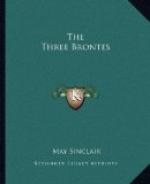And if Emily Bronte stands alone and is at her greatest in the things that none but she can do, she is great also in some that she may be said to share with other novelists; the drawing of minor characters, for instance. Lockwood may be a little indistinct, but he is properly so, for he is not a character, he is a mere impersonal looker-on. But Nelly Dean, the chief teller of the story, preserves her rich individuality through all the tortuous windings of the tale. Joseph, the old farm-servant, the bitter, ranting Calvinist, is a masterpiece. And masterly was that inspiration that made Joseph chorus to a drama that moves above good and evil. “‘Thank Hivin for all!’” says Joseph. “’All warks togither for gooid, to them as is chozzen and piked out fro’ the rubbidge. Yah knaw whet t’ Scripture sez.’” “’It’s a blazing shame, that I cannot oppen t’ blessed Book, but yah set up them glories to Sattan, and all t’ flaysome wickednesses that iver were born into the warld.’”
Charlotte Bronte said of her sister: “Though her feeling for the people round her was benevolent, intercourse with them she never sought; nor, with very few exceptions, ever experienced ... she could hear of them with interest and talk of them with detail, minute, graphic, and accurate; but with them she rarely exchanged a word.” And yet you might have said she had been listening to Joseph all her life, such is her command of his copious utterance: “‘Ech! ech!’ exclaimed Joseph. ‘Weel done, Miss Cathy! weel done, Miss Cathy! Howsiver, t’ maister sall just tum’le o’er them brocken pots; un’ then we’s hear summut; we’s hear how it’s to be. Gooid-for-naught madling! ye desarve pining fro’ this to Churstmas, flinging t’ precious gifts o’ God under fooit i’ yer flaysome rages! But I’m mista’en if ye shew yer sperrit lang. Will Hathecliff bide sich bonny ways, think ye? I nobbut wish he may catch ye i’ that plisky. I nobbut wish he may.’”
Edgar Linton is weak in drawing and in colour; but it was well-nigh impossible to make him more alive beside Catherine and Heathcliff. If Emily’s hand fails in Edgar Linton it gains strength again in Isabella. These two are the types of the civilized, the over-refined, the delicate wearers of silk and velvet, dwellers in drawing-rooms with pure white ceilings bordered with gold, “with showers of glass-drops hanging in silver chains from the centre”. They, as surely as the tainted Hindley, are bound to perish in any struggle with strong, fierce, primeval flesh and blood. The fatal moment in the tale is where the two half-savage children, Catherine and Heathcliff, come to Thrushcross Grange. Thrushcross Grange, with all its sickly brood, is doomed to go down before Wuthering Heights. But Thrushcross Grange is fatal to Catherine too. She has gone far from reality when she is dazzled by the glittering glass-drops and the illusion of Thrushcross Grange. She has divorced her body from her soul for a little finer living, for a polished, a scrupulously clean, perfectly presentable husband.




